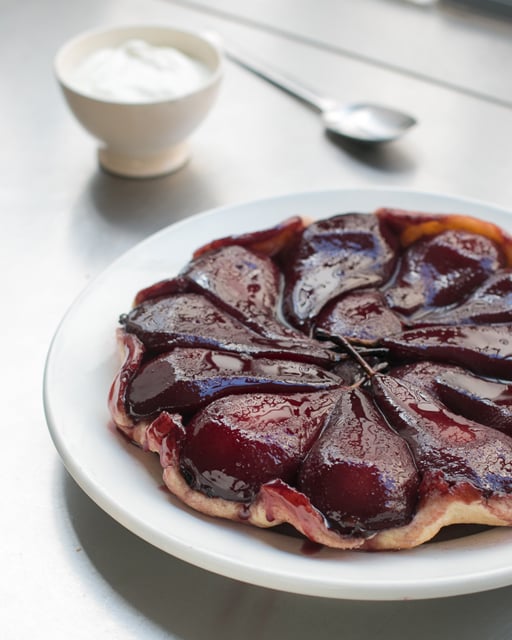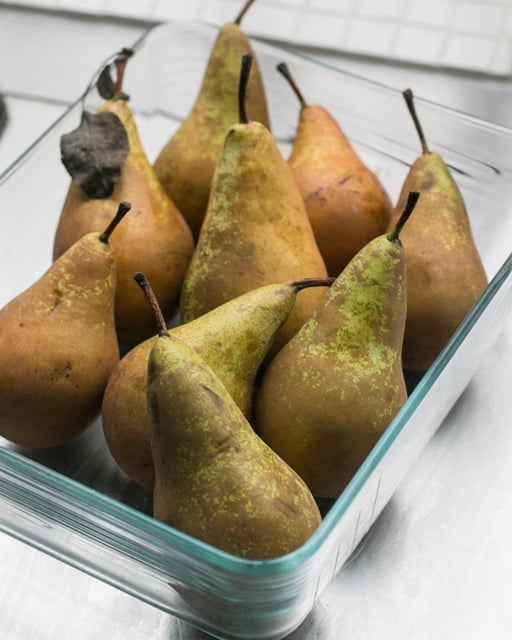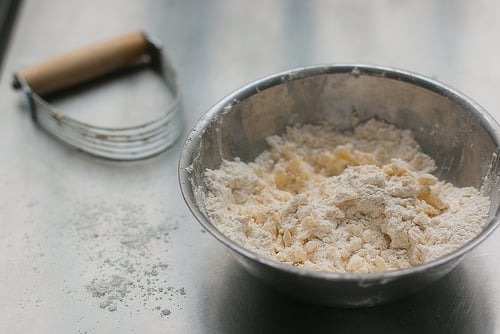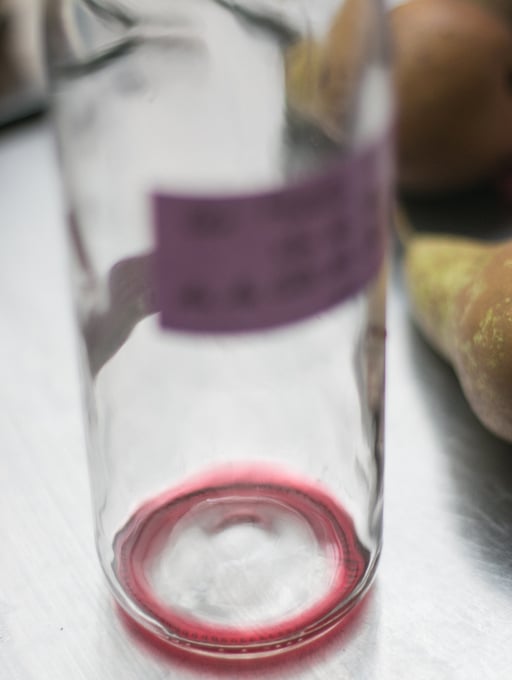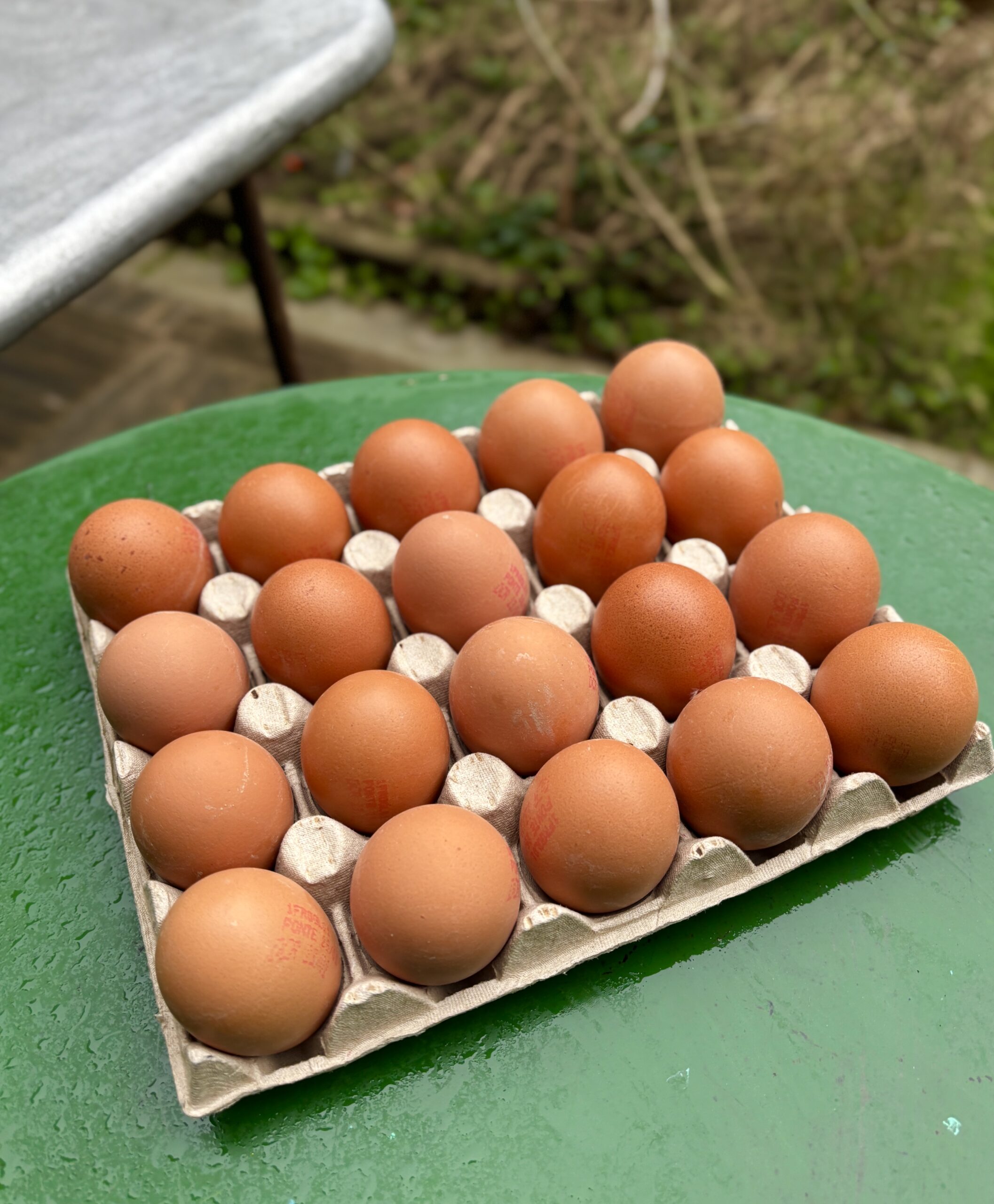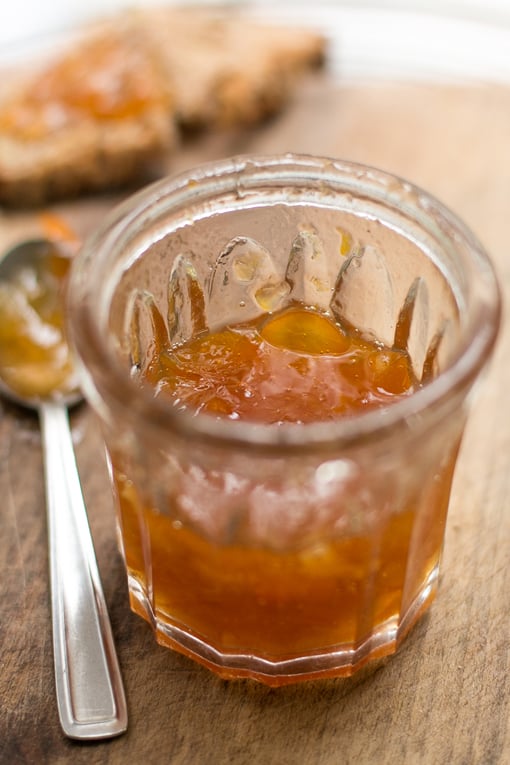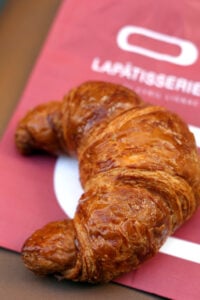Red Wine Poached Pear Tart
Some say that the French can be very narrow in their definitions of things, which is why traditional French cuisine can be so simple, yet spectacular; because the classics don’t get messed with. Other cuisines, however, do get modified to local tastes, like les brochettes de bœuf-fromage, or beef skewers with cheese, at les sushis restaurants, popcorn available as salty or sweet (!?), and while sandwiches stuffed with French fries may be a sandwich américain, I can’t say I’ve ever seen one in Amérique.
Americans spend a fair amount of time defending certain dishes, and some things are (or should be) rightly forbidden, like raisins in cole slaw and dried fruit in bagels, and others are debatable, like beans in chili, sugar or honey in cornbread. (But it’s okay to stop with those football-sized croissants.)
So when I was buying pears from the producteurs at the market, I mentioned to the vendor, who was rifling through all the pears as I pointed to each individual fruit that I wanted her to put in the bag, that I was going to make a sort of upside down pear tarte Tatin from them.
She stopped, mid-packing, with a look of complete and utter disbelief on her face, she told me she had never heard of such a thing. Which seemed funny because pears and apples are so close, that it would seem to be a natural, no? I think I threw her a curveball because a tarte Tatin is an apple tart, but I figured that was a rough way to describe what I was making, rather than a tarte renversée aux poires pochées, et au vin rouge de Carcassonne et aux épices, which was kind of a mouthful for 9am.
I’m not sure she was convinced, nor was I all that grammatically correct*, but I was looking forward to turning out a lovely tart with my mid-winter beauties.
The process takes a couple of days. For do-ahead folks, you’ll be happy to hear that it’s highly advisable to poach the pears 1 to 3 days in advance, so they have time to soak up the flavor and color of the wine.
You start with a fruity red wine. Because I share the French propensity for being thrifty, I bought a very inexpensive bottle of wine from Carcassonne, in the south, for poaching. If the wine is going to be simmered, then reduced to a syrup, there’s no need to pop open a bottle of Petrus. So don’t worry that the people at the cash register in the wine store are going to shoot you any attitude.
The fellow at my wine shop, who also expressed some reservations about this nervy American making an upside down tart with pears, of all things, didn’t bat an eye when I handed over my three one-euro coins for the bottle of wine that I pulled off the shelf.
The pears can be flavored with whatever you’d like; a few branches of thyme, or some crushed allspice berries can be swapped out for the cinnamon. And you could use a few wide strips of orange peel in place of the lemon. The French tend not to heavily season things, so the more singular flavors of the ingredients can shine through in the finished dish. (And in case you’re interested, I still prefer my popcorn salted, rather than sugared.) So just keep the poaching liquid to a couple of flavors and not a potpourri of ingredients that will overwhelm the pears. And the resulting red wine syrup is so good, you’ll thank me later for restraining any natural, or unnatural, urges to overdo it.
When I took the deeply red pears that had been poached a few days ahead outdoors to snap a picture for you, due to the shortened days of winter and my kitchen being too dark to get a nice shot to share, a passer-by asked, “Ce sont des fausses poires?” (“Are those fake pears?”)
But there was nothing fake about them, nor was the enjoyment my French friends expressed after polishing off the tart after dinner, scraping their plates clean. (I didn’t make up a fancy, or extended, name for it. I figured it would speak for itself.) It was so popular that I made it again a few days later. I forgot to bring a slice to the vendor at the market, or the guy at the wine shop, who are probably wondering about the crazy American with the odd ideas about baking, and the dicey French grammar. So I guess I’ll have to make it one more time. At least.
Red Wine Poached Pear Tart
The pears
- 1 (75cl) bottle fruity red wine
- 1 cup (250ml) water
- 2/3 cup (130g) sugar
- 1/4 cup (80g) honey
- 3 slices of fresh lemon
- 1 cinnamon stick
- a few turns of black pepper
- 8 medium-sized pears, (about 2 1/2-pounds, 1,25kg)
The dough
- 3/4 cup (110g) flour
- 2 teaspoons sugar
- 1/4 teaspoon salt
- 6 tablespoons (85g) unsalted butter, chilled, cut into cubes
- 2 tablespoons ice water
- In a large, non-reactive pot, heat the red wine, water, sugar, honey, lemon cinnamon, and black pepper.
- Meanwhile, peel the pears with a vegetable peeler, slice them in half lengthwise, and use a melon baller or teaspoon to scoop out the cores.
- When the red wine mixture is nearly boiling, slide the pears into the poaching liquid. Cover the pears with a round of parchment paper with a coin-sized hole cut in the center to let the steam escape. Reduce the heat to a simmer, and poach the pears over low heat for about 15 minutes, or until they are cooked through. To test, poke them with a tip of a paring knife; if it goes in easily, they are done. Do not overcook them.
- Remove the pears from the pot. Discard the lemon and cinnamon stick. Let the syrup cool until tepid, then pour it over the pears. (If you leave the pears in the syrup while it cools, they may get overcooked.) Cover and refrigerate the pears for 1 to 3 days.
- To make the dough, mix the flour, sugar, and salt in a bowl. Add the cubed butter and cut in with a pastry blender or a fork, until the pieces are the size of very small peas. (You can also make the dough in a food processor or stand mixer with the paddle attachment.) Add 2 tablespoons ice water and mix the dough until it comes together. If necessary, dribble a bit more water in, just until the dough holds together.
- Shape the dough into a disk, wrap it in plastic; refrigerate it for at least an hour. (The dough can be made up to 2 days in advance and refrigerated. It can also be frozen for up to 2 months.)
- To make the tart, pour off the red wine syrup into a wide, non-reactive saucepan and reduce the liquid over medium heat, until you have about 3/4 cup (250ml).. Keep an eye on the syrup during the final stages of the reducing; as it gets close, the liquid with foam a bit, which is a sign it’s done – or nearly there. Overcooking it will give it an undesirable caramel taste.
- Preheat the oven to 375ºF (190ºC.) Pour 1/3 cup (80ml) of the reduced syrup into a 9- to 10-inch (about 22cm) glass pie plate, baking dish, or similar sized pan. Arrange the pears in the baking vessel; don’t be reluctant to crowd them in so they overlap – they will bake down as they cook.
- On a lightly floured surface, roll out the dough so it is a bit larger than the diameter of the baking dish. Drape the dough over the pears. Tuck the edges of the dough down between the pears and the inside edges of the baking dish.
- Bake the tart for 45 to 50 minutes, or until the dough is a deep golden brown. Remove from oven and let cool on a wire rack for 10 to 15 minutes.
- Turning out the tart will require a bit of pluck. Keep in mind that there is hot, sticky liquid in the bottom of the tart that may spill out. So wear oven mitts and be careful when turning it out. The safest way to do it is to put an overturned rimmed baking sheet on top of the tart. Grab both sides of the baking sheet and the baked tart, hold them out away from you (not over you), and flip them over simultaneously and quickly, so the liquid doesn’t get a chance to spill out when you flip them. Slide the tart onto a serving platter. If you are very careful, you can turn it out directly onto a rimmed serving plate, taking the previously noted precautions about the hot syrup that may leak out.
Notes
*In case you were wondering, I had a fifteen minute discussion at home under the tutelage of my native Frenchman whether or not this was the correct way to say the name of this tart in French. Each word and punctuation mark got discussed and dissected, then scrutinized for grammar, flow, and – believe it or not, mood – to make it plus jolie, or “more beautiful.”
